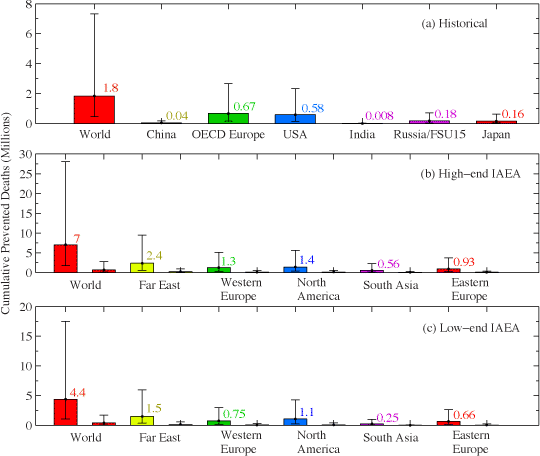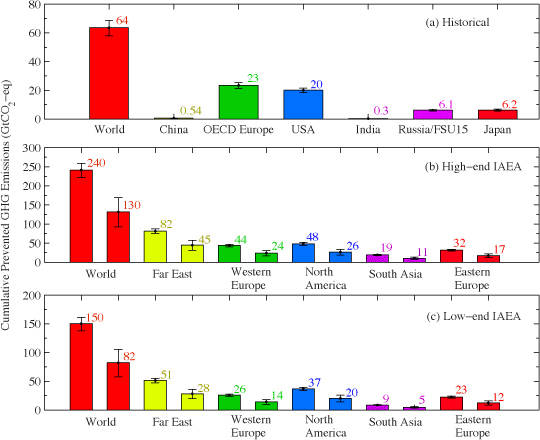我下面貼的是富比世一篇報導的簡單翻譯,內容是根據WHO統計及研究。結合實際死亡人數以及流行病學估計,各種電力來源每一兆度電力的致死量。(如果資料有誤請找作者,我只有嘗試翻譯一些重點和補充,最底下有計算的網頁)
第一頁是廣告,點一下右上角的Continue to site進入網頁
你用的電殺了多少人?
煤礦-世界平均 170,000
煤礦-中國 280,000
煤礦-美國 15,000
石油 36,000
天然氣 4,000
生質柴油 24,000
太陽能 440
風力 150
水力 1400
核能 90
下面有說明,煤礦在美國和中國會差異那麼大,主要是因為中國的發展太迅速,卻不重視環境保護,而美國會較重視靜電集塵器的裝設,其餘地區則要看當地注重環保的程度(而且中國還時常有煤礦礦災的情況)。另外燃燒石化燃料主要會是在非致死性的傷害會較為嚴重。
本文中對太陽能的主要考量是它的發電效率太低,要生產大量電力的話需要很大面積的土地。而其實如果把那些土地還原成荒野或者溼地,對地球的幫助還比較大。太陽能板安裝工人也可能於安裝過程中摔落致死,而且太陽能板跟屋頂間偶而會產生電弧,造成火災,所以最後算致死量440人。
另外可能作者主要是採美國觀點,所以沒有討論太陽能製造部分的污染,我補充一下大陸那邊對製造太陽能板污染及耗能的內容:
要把太陽能轉換成電源,需要巨大的太陽能板列陣收集陽光。
太陽能板主要製成原料是晶矽材料,包括多晶矽和單晶矽,其中,多晶矽更是太陽能產業命脈。
多晶硅生產過程,需要消耗很多能源,會造成很大污染。
中國北京交通大學光學技術教授簡水生估計,生產一千瓦發電力太陽能,需要10公斤多晶矽,但是這些電力只夠啟動一台冰箱一天。
製造多晶矽,需要大量燃煤,生產一塊1m×1.5m的太陽能板,就要燃燒超過40公斤煤,一塊太陽能板平均壽命20年。
40公斤的煤,足以讓中國最沒有效率的火力發電廠,生產130度電。這些電力可以讓2.2瓦LED燈泡,每天亮燈12小時長達30年。
另外,製造多晶矽過程會產生許多副產品,其中一種是四氯化矽。四氯化矽遇潮濕空氣分解成硅酸和劇毒氣體氯氫,會對眼睛和呼吸道產生強烈刺激,皮膚接觸后會引起組織壞死。
這些有害物質一旦回收處理不當外漏,對工人會有重大的安全隱患,對環境也會造成污染。
除此以外,還要考慮到太陽能板配備的蓄電池,廢棄以后會對環境造成的破壞。
太陽能板使用的蓄電池大部分是鉛酸蓄電池,含有大量鉛、銻、鎘、硫酸等有毒物質,會污染土壤、草原和地下水。
再來是風力,這邊主要是考慮裝設及保養時還是有工人會意外死亡,實際死亡人數不高,只是因為發電量太小,所以數字會比核能高。
水力發電主要是因為很稀有,但造成大量傷亡的潰壩事件,例如中國1975年的板橋(大陸的)水壩潰壩事件(文中是寫17萬人死亡,但我在wiki看到是23萬人)。
核能加入車諾比以及福島這兩件重大核事故,以及採集鈾礦的死亡之後,死亡人數卻還是很低,主要是因為核電廠數量雖然很少,但卻產生很大量的電力,讓死亡人數被稀釋了。還加上採LNT估計的死亡人數。另外美國內部因輻射死亡的主要是核武研究設施意外死亡的及少數人及LNT估計的人數。
(LNT 直線無下限理論-亦即輻射劑量增加時風險即增加,劑量與風險呈線性關係。曝露於高劑量的環境下,在數天後組織會受到嚴重的傷害,低劑量環境下,可能會於數年後發生延遲效應-癌病。這也把一些反核者"一點輻射都不能有"的觀點考量進去。)
而且其實發生事故的都是採用舊設計的第二代反應爐,現在新建的反應爐至少都是第三四代以上。此外還採用過度(redundant字義是多餘的)安全的被動保護系統。來確使新核電廠能安然度過發生機率很低的重大災害。只是除了我們現有的技術之外,我們還要更加努力發展發電以及核廢料處理技術。
下面是該文作者在底下對一些質疑的回應。
No, I don’t think so, since I’ve worked on all sides of the issue, am a rather radical progressive and definitely do not tow the party line, and am a scientists that just cannot ignore reality. Take nuclear waste, for instance. But the real problem is that both sides tend to not look at relative risk which is everything. No one is saying nuclear energy is perfectly safe or that anything else is perfectly horrible. It’s all about relative risk, and a society has to decide that for not just the immediate future, but for 20 or 50 years or longer. Also, no one would dream of building another GenII reactor, or a 1980s solar array, or use a 486 computer, so why does everyone compare these old reactors to new technologies from other sources? True, all we have are old reactors just because they’ve worked so long so well. But we do have to replace them with GenIII and IV at some point.
我從各個層面保持中立及前瞻的研究這項議題。我是個無法忽略現實情形的研究學者。其實大家都不注重相對風險。我並不是要表示核能絕對安全或是其他能源都很糟,這些都是比較下的結果。而我們不該只考慮當下,而該考慮經過20年甚至50年後這些決定對地球所造成的影響。
話說,現在一般正常人不會想要回頭建造第二代反應爐、1980年代的太陽能板或拿一台486電腦來玩Candy Crush。但為何總要拿舊型的反應爐來跟其他能源的新科技比較?雖然說我們現在大多還是舊型的反應爐(主要是因為他們大多都還運作的很好)。但年限到之後我們還是會用第三四代的反應爐等新技術來取代他們。
個人粗略翻譯,有錯誤煩請指正
補充:底下是與這篇文章有關的計算,其實我相信沒啥人會進去看(這是2008年的計算,所以核能部分數字比這篇少一點)
計算方式
翻譯中文很難 做的不好請諒解.
Coal and gas are far more harmful than nuclear power
燃煤和燃燒天然氣比核能還更有害
April 22, 2013
四月二十二號,兩千零十三年
By Pushker Kharecha and James Hansen,
NASA Goddard Space Flight Center
Human-caused climate change and air pollution remain major global-scale problems and are both due mostly to fossil fuel burning. Mitigation efforts for both of these problems should be undertaken concurrently in order to maximize effectiveness. Such efforts can be accomplished largely with currently available low-carbon and carbon-free alternative energy sources like nuclear power and renewables, as well as energy efficiency improvements.
人類造成的氣候變遷和空氣汙染依舊是全球性主要的問題,並且大多數是因為燃燒石化燃料而造成的.對於緩解氣候變遷和空氣汙染的努力是必須要同時進行的,這樣效果才會最好.如何大規模地緩解氣候變遷和空氣汙染,我們可以使用目前可行的低排碳或是零排碳的代替能源,好比說核能和可再生能源.使用核能和可再生能源更可以改善能源的效率(註一).

Cumulative net deaths prevented assuming nuclear power replaces fossil fuels. The top panel (a) shows results for the historical period in our study (1971-2009), with mean values (labeled) and ranges for the baseline historical scenario. The middle (b) and bottom (c) panels show results for the high-end and low-end projections, respectively, of nuclear power supply estimated by the IAEA (ref. 4) for the period 2010-2050. Error bars reflect the ranges for the fossil fuel mortality factors listed in Table 1 of our paper. The larger columns in panels (b) and (c) reflect the all-coal case and are labeled with their mean values, while the smaller columns reflect the all-gas case; values for the latter are not shown because they are all simply a factor of about 10 lower (reflecting the order-of-magnitude difference between the mortality factors for coal and gas). Countries/regions are arranged in descending order of CO2 emissions in recent years. FSU15=15 countries of the Former Soviet Union and OECD=Organization for Economic Cooperation and Development.
圖一,使用核能替代石化能源所能避免的累積死亡總數.(Cumulative Prevented Deaths). 最上面一個圖表是根據我們(美國)研究資料,顯示出從1971-2009的數據.標示出來的數字為平均值和根據歷史事件所得到的基線(註二)中間和最下面的圖表的數據是根據IAEA(International Atomic Energy Agency國際原能會)對於2010-2050的推算(中間為高規格核能供應而最下面的圖為低規格核能供應).顯示錯誤的線條(Error Bar)反應出石化燃料的致死因素(致死因素可以在table1找到---註三).在中間和最下面的兩張圖表中,比較大的條柱是代表燃煤而較小的條柱為使用天然氣.
In a recently published paper (ref. 1), we provide an objective, long-term, quantitative analysis of the effects of nuclear power on human health (mortality) and the environment (climate). Several previous scientific papers have quantified global-scale greenhouse gas (GHG) emissions avoided by nuclear power, but to our knowledge, ours is the first to quantify avoided human deaths as well as avoided GHG emissions on global, regional, and national scales.
The paper demonstrates that without nuclear power, it will be even harder to mitigate human-caused climate change and air pollution. This is fundamentally because historical energy production data reveal that if nuclear power never existed, the energy it supplied almost certainly would have been supplied by fossil fuels instead (overwhelmingly coal), which cause much higher air pollution-related mortality and GHG emissions per unit energy produced (ref. 2).
在最近發表的一些研究(ref.1)對於核能對人類健康的影響(致死率)和環境的變遷,我們提供了一個客觀和長期性並量化的分析.前一段時間所發表的科學研究,都是專注於量化(數據化)核能所能減少的溫室效應氣體.我們的研究是第一個不只專注於溫室效應氣體上,並且數據化”使用核能能避免的人類死亡”.
這個研究還顯示出:如果沒有使用核能,對於減緩人類所造成的氣候變化和空染會更加困難.這個論點是根據歷史的數據,所提出來的假設: 如果核能從來沒有被發明(存在),人能的能源會完全依賴石化能源(絕大多數會是煤),而使用煤會導致更多人死於空氣污染相關的疾病,並且會產生出更多的溫室效應氣體(溫室效應氣體/每能量單位).

Mean net deaths prevented annually by nuclear power between 1971-2009 for various countries/regions. Ranges not shown but are a factor of ~4 higher and lower than the mean values.
Using historical electricity production data and mortality and emission factors from the peer-reviewed scientific literature, we found that despite the three major nuclear accidents the world has experienced, nuclear power prevented an average of over 1.8 million net deaths worldwide between 1971-2009 (see Fig. 1). This amounts to at least hundreds and more likely thousands of times more deaths than it caused. An average of 76,000 deaths per year were avoided annually between 2000-2009 (see Fig. 2), with a range of 19,000-300,000 per year.
我們參考了其他學術文章,綜合了過去電能生產的資料,致死率,和氣體排放的因素,我們發現,若去掉三個世界上主要的核能事故(註四),在1971-2009年之間,使用核能能防止平均超過”一百八十萬”的死亡案例.而確切的數字可能比這一百八十萬高出百倍甚至千倍.在2000-2009平均一年最少可以防止七萬六千起的死亡案例,至多每年可以防止一萬九千到三十萬的死亡案例.
Likewise, we calculated that nuclear power prevented an average of 64 gigatonnes of CO2-equivalent (GtCO2-eq) net GHG emissions globally between 1971-2009 (see Fig. 3). This is about 15 times more emissions than it caused. It is equivalent to the past 35 years of CO2 emissions from coal burning in the U.S. or 17 years in China (ref. 3) — i.e., historical nuclear energy production has prevented the building of hundreds of large coal-fired power plants.
同樣地,根據我們的計算,如果使用核能,在1971-2009年之間,全球能夠避免排放出64gigatoones( 1 gigatonne = 10^9 噸, 一噸 = 一千公斤) 的溫室效應氣體.(使用煤和核能所產生的溫室效應氣體相差至少有15倍之多).這個量差不多同等於美國35年燃煤所產生的量,或者是中國7年燃煤產生的量.(ref. 3)即,歷史上核能所產生出來的電已經避免了幾百座大型燃煤發電廠了.
To compute potential future effects, we started with the projected nuclear energy supply for 2010-2050 from an assessment made by the UN International Atomic Energy Agency that takes into account the effects of the Fukushima accident (ref. 4). We assume that the projected nuclear energy is canceled and replaced entirely by energy from either coal or natural gas. We calculate that this nuclear phaseout scenario leads to an average of 420,000-7 million deaths and 80-240 GtCO2-eq emissions globally (the high-end values reflect the all coal case; see Figs. 1 and 3). This emissions range corresponds to 16-48% of the "allowable" cumulative CO2 emissions between 2012-2050 if the world chooses to aim for a target atmospheric CO2 concentration of 350 ppm by around the end of this century (ref. 5). In other words, projected nuclear power could reduce the CO2 mitigation burden for meeting this target by as much as 16-48%.
為了要計算核能對於未來潛在的影響,我們根據聯合國國際原能會所做出的估算(其估算涵蓋了福島核能事故的影響),我們假設,在2010-2050年之間,如果現今規劃中的核子能源能完全被燃燒石化燃料所取代,我們計算了這個核能停建/停運的情況會”多”造成全球平均四十二萬到七百萬的死亡案件,並且會多產出80-240 gigatonnes的溫室效應氣體.這個排放量同等於16-48%在2010-2050所允許的全球碳排放量(這個允許碳排放量是以在這個世紀結束前維持空氣中的二氧化碳維持在350ppm的目標以下而推算出來的)(ref.5) 換而言之,在本世紀結束前,如果我們想要達成二氧化碳在大氣中只有350ppm以下的目標,繼續使用或興建既定的核電廠來產生能源能夠減緩16-48%對於二氧化碳排放的負擔.

Cumulative net GHG emissions prevented assuming nuclear power replaces fossil fuels. The three panels are ordered the same as in Fig. 1, except that mean values for both the all coal and all gas cases are labeled. Error bars reflect the ranges for the fossil fuel emission factors listed in Table 1 of our paper.
The largest uncertainties and limitations of our analysis stem from the assumed values for impacts per unit electric energy produced. However, we emphasize that our results for both prevented mortality and prevented GHG emissions could be substantial underestimates. This is because (among other reasons) our mortality and emission factors are based on analysis of Europe and the US (respectively), and thus neglect the fact that fatal air pollution and GHG emissions from power plants in developing countries are on average substantially higher per unit energy produced than in developed countries.
(以上沒翻譯)
Our findings also have important implications for large-scale "fuel switching" to natural gas from coal or from nuclear. Although natural gas burning emits less fatal pollutants and GHGs than coal burning, it is far deadlier than nuclear power, causing about 40 times more deaths per unit electric energy produced (ref. 2).
我們也發現大規模的使用天然氣(取代煤和核能)會有重大的牽連關係.雖然燃燒天然氣已取得能源確實比燃燒煤炭更能夠減低產生的致死汙染物和溫室效應氣體,但是與核能相比,燃燒天然氣還是顯得危險致命的多了,以平均產生一單位電能來說,燃燒天然氣會造成比核能多出大約四十倍的死亡案件.
Also, such fuel switching is practically guaranteed to worsen the climate problem for several reasons. First, carbon capture and storage is an immature technology and is therefore unlikely to constrain the resulting GHG emissions in the necessary time frame. Second, electricity infrastructure generally has a long lifetime (e.g., fossil fuel power plants typically operate for up to ~50 years). Third, potentially usable natural gas resources (especially unconventional ones like shale gas) are enormous, containing many hundreds to thousands of gigatonnes of carbon (based on ref. 6). For perspective, the atmosphere currently contains ~830 GtC, of which ~200 GtC are from industrial-era fossil fuel burning.
並且,把能源生產完全依賴天然氣實際上必定會加深氣候問題. 原因為: 第一,捕捉碳的技術和儲存的技術還不成熟,因此,在一段特定的時間內不太可能會限制溫室效應的排放.(作者應該是指在技術未成熟之前的一段時間內,因為碳捕捉和儲存的技術不健全而沒有有效的方法抑止碳排放,所以限制碳排放的標準會不高) 第二, 電力設施基本上都有很長的壽命,比如說,燃燒石化的電廠通常都能運轉五十年.(因此,既然蓋好了,就會用到年限,等於在年限之前都會繼續排放大量的溫室效應氣體和有毒物質) 第三,潛在可用的天然氣資源是非常巨大的,尤其是油頁岩. 包含數百到數千億的碳.(ref.6) (作者應是指,因為天然氣資源儲存量大,相對的人類容易造成對其的依賴,如果沒有用到底,人類不會去開發新的能源,就像是現在對石油的依賴). 現在的大氣層中大約有830億噸的碳,其中有大約200億噸的碳是從工業時代開始後累積下來的.
We conclude that nuclear energy — despite posing several challenges, as do all energy sources (ref. 7) — needs to be retained and significantly expanded in order to avoid or minimize the devastating impacts of unabated climate change and air pollution caused by fossil fuel burning.
結論,撇除核能會面對到的困難(每種能源都會要面對到不同的困難),為了避免或減少石化燃料所造成的氣候變遷和空氣汙染,核能是有其必要被保留下來並且顯著地擴大營運.
References
1. Kharecha, P.A., and J.E. Hansen, 2013: Prevented mortality and greenhouse gas emissions from historical and projected nuclear power. Environ. Sci. Technol., in press, doi:10.1021/es3051197.
2. Markandya, A., and P. Wilkinson, 2007: Electricity generation and health. Lancet, 370, 979-990, doi: 10.1016/S0140-6736(07)61253-7.
3. Boden, T. A., G. Marland, R.J. Andres, 2012: Global, Regional, and National Fossil-Fuel CO2 Emissions. Carbon Dioxide Information Analysis Center, Oak Ridge National Laboratory, U.S. Department of Energy, Oak Ridge, Tenn., U.S.A., doi:10.3334/CDIAC/00001_V2012.
4. International Atomic Energy Agency, 2011: Energy, Electricity and Nuclear Power Estimates for the Period up to 2050: 2011 Edition. IAEA Reference Data Series 1/31. Available at http://www-pub.iaea.org/MTCD/Publications/PDF/RDS1_31.pdf
5. Hansen, J., P. Kharecha, Mki. Sato, V. Masson-Delmotte, et al., 2013: Scientific prescription to avoid dangerous climate change to protect young people, future generations, and nature. PLOS One, submitted.
6. GEA, 2012: Global Energy Assessment — Toward a Sustainable Future. Cambridge University Press, Cambridge, UK and New York, NY, USA and the International Institute for Applied Systems Analysis, Laxenburg, Austria. Available at http://www.globalenergyassessment.org.
7. Kharecha, P.A., C.F. Kutscher, J.E. Hansen, and E. Mazria, 2010: Options for near-term phaseout of CO2 emissions from coal use in the United States. Environ. Sci. Technol., 44, 4050-4062, doi:10.1021/es903884a.
註一 : (改善)能源效率: [原文] energy efficiency improvements : 用更少的能源提供同樣的服務.( Energy efficiency is "using less energy to provide the same service".)
註三:網站上沒有找到 table1
註四:三件主要核能事故應該為:三哩島事件,車諾比事件,福島事件.
rok503 wrote:
我下面貼的是富比世的...(恕刪)
Chpa wrote:
其實說難聽點
日本在開始建造 核能發電廠時也不知道會發生意外
蘇俄在建造 車諾堡核電廠時也不知道會發生意外
如果真的台灣發生意外時你會怎麼做 這樣就好
在來反過來說 我當時沒支持
事實上就是 現今世界上 人類還沒辦法 真正解決的核能問題
你說的這個應該可以套用在"任何"意外上。
天然氣爆炸前 沒人知道會發生意外
車禍前 沒人知道會發生意外
水庫崩塌前 沒人知道會發生意外
任何意外發生前 沒人知道會發生意外
現今世界上 人類還沒辦法 真正解決的空氣污染及溫室效應問題
話說,火力發電廠要殺人,連意外都不需要
Chpa wrote:
世界上好幾座的核電廠 廢除了 但根本沒辦法停止核反應 只能用水泥完全封死
就是說 人類文明至今 還沒辦法控制核反應
使用核能 是一場賭博
你在胡扯什麼 = =
現在有用水泥封的也只有車諾比,哪來好幾座。
那裡面的中子也被倒下去的碳化棚吸收,現在也沒有持續進行核分裂反應,只剩原本的衰變物質還有點殘熱。現在封起來主要是怕粉塵散出。
車諾比內原本有四部反應爐,1986發生事故的是四號爐。其餘三部仍繼續運作,後面陸續除役,到2000年才關閉。
使用能源本來就要付出代價,無論火力、風力、太陽能、水力、核能都是這樣。
同樣期望值的情況下,賭博時你會想押貴的還是便宜的?



































































































